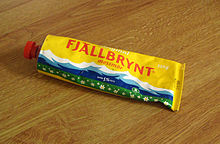- Brunost
-
 Brunost is usually sliced very thinly using a metal cheese slicer
Brunost is usually sliced very thinly using a metal cheese slicer
Brunost (Norwegian), or mesost (Swedish), mysuostur (Icelandic) or myseost (Danish) is a brown Scandinavian whey cheese. The Norwegian name brunost means brown cheese, and the others mean simply whey cheese. In North America a variant with goat milk is referred to and sold as gjetost (Norwegian for goat cheese).
Contents
Production
Brunost is made by boiling a mixture of milk, cream and whey carefully for several hours so that the water evaporates. The heat turns the milk sugar into caramel which gives the cheese its characteristic taste. It is ready for consumption as soon as it is packed in suitable sized blocks. A low-fat variant is made by increasing the proportion of whey to milk and cream.
If boiled for a shorter time than usual, one gets the spreadable version called prim in Norwegian (or messmör in Swedish and mysingur in Icelandic), similar to Dulce de leche. Prim had been made in Norway for a long time when Anne Haav (Anne Hov in some sources), a farmer's wife in Gudbrandsdalen, got the idea of putting cream into the cheese and invented the Fløtemysost. She found that the cheese was better and easier to cut by increasing the percentage of fat by the addition of cream. She received a good price for her new cheese, and this merchandise is said to have saved the Gudbrandsdalen financially in the 1880s. In 1933, when Anne Haav was 87 years old, she was awarded the King's Medal of Merit in silver.
Brunost is manufactured primarily in Norway, but also has traditionally been produced in Jämtland and Härjedalen in Sweden. The cheese is sold by specialty cheese shops and some larger supermarkets within North America and Europe. Today several types of brunost are offered in most shops in Norway and Sweden. Brunost has traditionally been considered healthy because of its high content of iron, calcium and B vitamins, but more contemporary views by nutrition experts differ. The Norwegian nutrition expert Fedon Lindberg says that because brunost has large quantities of both fat and sugar it's comparable to chocolate. He says that Norwegians should cut down on their brunost consumption.
TINE produces most of the brunost in Norway, and currently have 12 varieties to choose among. Fjällbrynt is the biggest producer in Sweden. In Sweden, brunost called Fjällbrynt Mesost is produced commercially by Fjällbrynt in the city of Östersund. In Iceland, the company Mjólkursamsalan produces brunost. Several local dairies in Norway produce their own versions.
References
Other sources
- Espelund, Arne (1998) Brunosten, historien til et godt næringsemne gjennom 300 år (Trondheim: Arketype forlag) ISBN 82-992430-2-5
External links
- (Norwegian) Brunost (Store norske leksikon: Preben S. Ottesen)
- (Norwegian) TINE, the main Norwegian producer of Brunost
- Norseland, TINE's North American subsidiary company
- (Norwegian) Synnøve Finden, another Norwegian producer of Brunost
- (Swedish) Milko, the main Swedish producer of mesost
- (Icelandic) Mjólkursamsalan (or MS), the Icelandic producer of mysuostur
http://www.dagbladet.no/dinside/2003/08/15/376020.html
Whey cheeses Anari (cheese) • Anthotyros • Brunost • Manouri • Mizithra • Ricotta • Urdă • Xynomizithra
Norwegian cheeses Brunost • Fløtemysost • Gamalost • Jarlsberg cheese • Kavli • Nøkkelost • Primost • Pultost • SnøfriskCategories:- Norwegian cheeses
- Goat's-milk cheeses
- Spreads
- Whey cheeses
Wikimedia Foundation. 2010.

